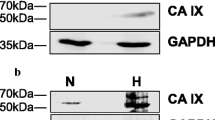Abstract
Background: There is evidence that chronic local ischemia may be one possible etiology of prostatic atrophy (PA). Our aim was to study the expression of hypoxia induced factors in areas of PA. Design: The immunohistochemical expression of hypoxia-inducible factor-1 alpha (HIF-1) and vascular endothelial growth factor (VEGF) was studied in atrophic acini of 33 needle prostatic biopsies. Prostatic atrophy was the only diagnosis in these biopsies. For HIF-1alpha, a total of 27,158, 10,060 and 9920 nuclei were counted in atrophic acini, acini with squamous metaplasia, and acini without squamous metaplasia surrounding acute infarct, respectively. For VEGF, a total of 24,966, 9849 and 9918 nuclei were counted for the same acini. A total of 1326 nuclei were counted in acini of the needle biopsy used as negative control. The Student’s test for independent samples with significance level at 5% (p<0.05) was used to compare the mean ratio (MR) of positive nuclei over total nuclei for HIF-1 and VEGF. Results: For HIF-1, 108 (MR = 0.004), 6877 (MR = 0.68), and 6566 (MR = 0.66) nuclei were positive in atrophic acini, acini with squamous metaplasia, and acini without squamous metaplasia surrounding acute infarct, respectively. There was a highly significant difference (p<0.001) between atrophic acini and acini surrounding acute infarct. For VEGF, 139 (MR = 0.05), 5926 (MR = 0.60), and 4948 (MR = 0.50) nuclei were positive in the same acini. The difference was highly significant (p<0.001). All 1326 nuclei counted in the needle biopsy with essentially normal findings were negative for HIF-1 and VEGF. Conclusions: This study showed that prostatic atrophic acini are not on acute ischemia. However, local chronic ischemia cannot be ruled out. Experimental data showed that on chronic ischemia, the signal triggering HIF-1alpha accumulation may disappear despite continuous hypoxia suggesting that compensatory mechanisms triggered during prolonged hypoxia may be able to restore normal tissue oxygen levels.
Similar content being viewed by others
References
Moore RA (1936). The evolution and involution of the prostate gland. Am J Pathol 12: 599–624
Franks LM (1954). Atrophy and hyperplasia in the prostate proper. J Pathol Bacteriol 68: 617–621
Liavag I (1968). Atrophy and regeneration in the pathogenesis of prostatic carcinoma. Acta Pathol Microbiol Scand [A] 73: 338–350
Cheville JC and Bostwick DG (1955). Postatrophic hyperplasia of the prostate. A histologic mimic of prostatic adenocarcinoma. Am J Surg Pathol 19: 1068–1076
Billis A (1988). Prostatic atrophy: an autopsy study of a histologic mimic of adenocarcinoma. Mod Pathol 11: 47–54
Rich AR (1935). On the frequency of occurrence of occult carcinoma of the prostate. J Urol 33: 215–223
Ro JY, Sahin AA and Ayala AG (1995). Tumors and tumorous conditions of the male genital tract. In: Fletcher, CDM (eds) Diagnostic Histopathology of Tumors, pp 521–523. Churchill Livingstone, Edinburgh
Humphrey PA (2003). Atrophy. In: Humphrey, PA (eds) Prostate Pathology, pp 101–112. ASCP Press, Chicago
Meirelles LR, Billis A and Cotta ACS (2002). Prostatic atrophy: evidence for a possible role of local ischemia in its pathogenesis. Int Urol Nephrol 34: 345–350
Semenza GL (1998). Hypoxia inducible factor-1: master regulator of O2 homeostasis. Curr Opin Genet Dev 8: 588–594
Semenza GL (1999). Regulation of mammalian O2 homeostasis by hypoxia-inducible factor-1. Annu Rev Cell Dev Biol 15: 551–578
Semenza GL, Agani F and Feldser D (2000). Hypoxia, HIF-1, and the pathophysiology of common human diseases. Adv Exp Med Biol 475: 123–130
Kozlowski R, Kershen RT and Siroky MB (2001). Chronic ischemia alters prostate structure and reactivity in rabbits. J Urol 165: 1019–1026
Border WA and Noble NA (1994). Transforming growth factor beta in tissue fibrosis. New Engl J Med 331: 1286–1292
Chávez JC, Agani F and LaManna JC (2000). Expression of hypoxia-inducible factor-1 α in the brain of rats during chronic hypoxia. J Appl Physiol 89: 1937–1942
Author information
Authors and Affiliations
Corresponding author
Rights and permissions
About this article
Cite this article
Meirelles, L.R., Billis, A., Magna, L.A. et al. Prostatic atrophy: Immunohistochemical study of hypoxia induced factors. Int Urol Nephrol 38, 577–581 (2006). https://doi.org/10.1007/s11255-006-6657-4
Published:
Issue Date:
DOI: https://doi.org/10.1007/s11255-006-6657-4




